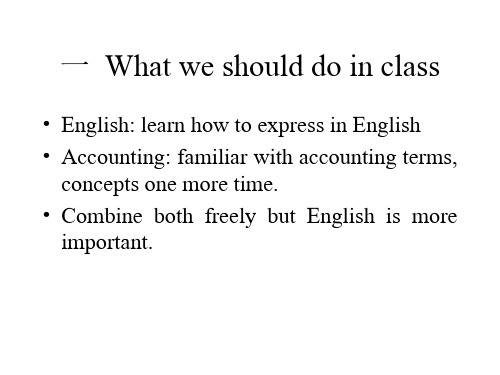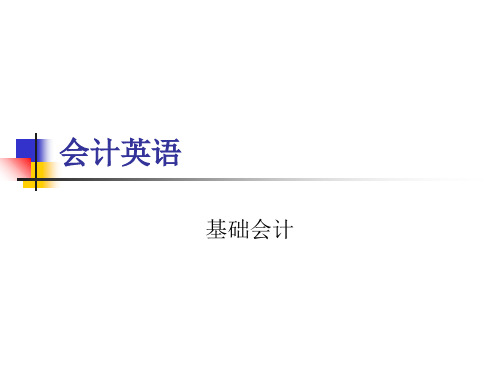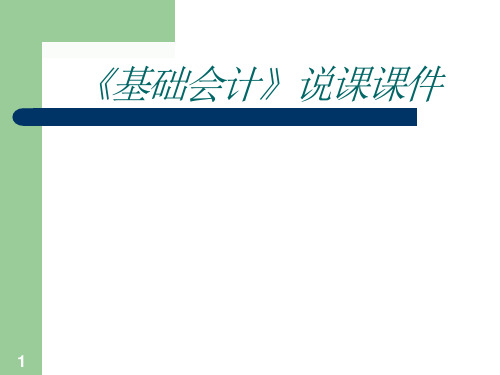会计英语—基础会计.ppt
会计英语 课件

VS
用于发出指示、命令或请求,在会计英语中常用于指示、建议或要求执行某些操作。
示例
Please ensure that all financial transactions are accurately recorded.(请确保所有财务交易都准确记录。)
祈使句结构
05
Accounting English Reading and Writing
Accounting English writing often requires the ability to present complex information in a structured and coherent manner. Students should have strong organizational skills, using headings, subheadings, and tables to guide the reader through the information.
Comprehension of financial reports: This skill involves the ability to read and understand financial reports such as balance sheets, income statements, and cash flow statements. It requires knowledge of accounting vocabulary and concepts to understand the information presented in these reports.
Financial Statements
会计专业英语PPT

Management accounting:
use both historical data in assisting management daily operations and in planning future operations.
concepts one more time. • Combine both freely but English is more
important.
二 Improve English by ….
– Read textbook in class and after class – Remember new words – Answer questions in exercise is important – Overlook some parts while emphasizing some
• Financial accounting: provides external reports o outsiders, financial information.
2 Reporting management information to internal users
Internal users are senior management-level personnel.
• What do you think?
二 Functions
1 Reporting financial information to outside interested users
• Outside users are:investors,banks and other creditors,government agencies,general publics
基础会计要点PPT课件

贷:应付利息 借:应付利息
贷:银行存款
(3)到期还本 借: 短期借款
贷:银行存款
如果平时利息不预提,最 后一次还本付息
借: 短期借款 财务费用
贷:银行存款
二、供应过程业务
1、采购
借:材料采购——××材料 应交税费——应交增值税(进项税额) 贷:银行存款(或者“应付账款”、“应付票据”
会计操作工作
——初、中等会计的饭碗 ——有确定的手段和程序,不允
许随心所欲,妙笔生花
如何学好会计
一听 二思 三看 四问 五商 六练
会计的一些基本理论
会计假设
会计假设的含义 基本会计假设
– 会计主体 – 持续经营 – 会计分期 – 货币计价
会计目标
会计目标含义 会计信息使用者 会计目标内容
反映企业一定时期内经营成果的文件;
反映企业一定时期内现金流量情况的 文件。
会计报表的种类
会 计 报 表
分类标准 经济内容 编制时间
服务对象 编制单位 会计主体
分类结果
报表名称
财务状况
资产负债表、现金流量表、所有者权益变动表
经营成果
利润表
中期 报表
月报 资产负债表、利润表
季报
年报 外部报表
资产负债表、利润表、现金流量表、所有者权 益变动表
会计是干什么的?
会计的本质
会计——提供信息使用者需要信 息的经济信息系统,也是一项管 理活动。
会计的档次(企业会计)
初等会计 中等会计 高层次会计
初等会计
“学徒”——一招一式基本功都要会
——心如止水,悬梁刺股
知识准备——基础会计学、中级会计学等
入门——基础会计学——会计的“识字” 课
会计英语 ppt

debit must have credit and credit is equal to debit
First,when you use the debit and credit accounting, for each economic business,not only to record an (or several) account debit,bu also record another lender (or several) account that is debit must have credit .and debit must be equal to credit.second the accounts can be recorded the same account and can also not the same account, but it must be two direction of charge to an account, neither debite,nor credite.
This equation, called financial condition equation, it reflects the assets, liabilities and owners' equity, the relationship between the three accounting elements reveals the enterprise at a specific point of the financial situation. To be specific, it shows that the enterprise at a specific point of various assets and creditors and investors on the basic situation of enterprise assets claims, shows that the enterprise assets, all are provided by the investors and creditors.
会计英语第五版

会计英语第五版简介《会计英语第五版》是一本专门为会计专业学生和从业人员准备的英语教材。
本教材旨在帮助学生掌握并运用会计相关的英语词汇和表达方式,提高他们在国际商务环境中的沟通能力。
目录1.第一单元:会计基础– 1.1 会计的定义和职能– 1.2 会计的基本原理– 1.3 会计的分类和应用2.第二单元:会计准则和规范– 2.1 国际会计准则概述– 2.2 资产负债表– 2.3 损益表– 2.4 现金流量表3.第三单元:财务报表分析– 3.1 比率分析– 3.2 多年度比较分析– 3.3 垂直和水平分析– 3.4 公司绩效评估4.第四单元:成本会计– 4.1 成本会计的基本概念– 4.2 成本会计的方法和技术– 4.3 成本会计体系5.第五单元:预算和预测– 5.1 会计预算的概念和目的– 5.2 预算编制和控制– 5.3 预测方法和技术章节概述第一单元:会计基础本单元将介绍会计的定义和职能,帮助学生了解会计的基本原理和分类。
学生将学会使用正确的会计术语和表达方式,为后续的学习打下基础。
第二单元:会计准则和规范在本单元中,学生将学习国际会计准则的概述,并深入了解资产负债表、损益表和现金流量表的编制和分析方法。
他们将学会如何解读和分析财务报表,评估公司的财务状况。
第三单元:财务报表分析本单元将重点介绍财务报表分析的方法和工具,包括比率分析、多年度比较分析、垂直和水平分析等。
学生将学会如何利用这些分析工具评估公司的绩效并作出合理的决策。
第四单元:成本会计在本单元中,学生将深入了解成本会计的基本概念、方法和技术。
他们将学会如何计算和分配成本,并理解成本会计在管理决策中的重要性。
第五单元:预算和预测本单元将介绍会计预算的概念和目的,帮助学生学会编制和控制预算。
他们将学习各种预测方法和技术,为公司未来的发展提供参考和决策支持。
学习方法学生可以按照以下方法来学习《会计英语第五版》:1.阅读课本并理解每个章节的主要概念和要点。
会计英语课件

accounting element _会__计_要__素__
2. Complete the following sentences.
❖ 1)Accounting is a _s_pe_c_ia_l l_a_ng_u_age of business. ❖ 2) The purpose of accounting is to provide
❖Is Accounting English difficult?
Suggestions for study
❖ Previewing the text is very important.
❖ 《An English –Chinese Dictionary of Accounting》,《英汉双解财会词典》
❖ Economic resources = equities ❖ Economic resources =creditor’s equity + owner’s
equity ❖ Accounting equation: assets = liabilities of transactions that affect owner’s equity
and know why they need the information; ❖ Understand the types of accounting information; ❖ Have a general idea of the professional fields of
accounting and their duties. ❖ Learn the accounting terms in this chapter and
use them in the translation task.
基础会计复习PPT

• 2.作用:决定了资产计价和收益确定问题,同时 也为流动资产/非流动资产和流动负债/非流动负 债的划分提供了基础。
• 3.注意:如果可以判定企业不能持续经营,就应
当改变会计核算的 原则和方法, 并在财务报告中作相应说明。
Back to school
• (三)会计分期
• 1.含义:是将一个企业持续经营的生产经营活动 划分为首尾衔接,间隔相等的期间。
Back to school
• 三、会计的基本职能(会计干什么?)
(一)会计的核算职能
会计核算职能是指会计以货币为主要计量单位 ,通过对特定主体的经济活动进行确认、计量、 记录和报告,真实、完整地反映特定主体的财务 状况、经营成果和现金流量等信息的功能。 (二)会计的监督职能
会计的监督职能是指会计在其核算过程中,对 经济活动的合法性和合理性所实施的审查。
• 会计主体可以是法人,如企业或事业单位、也可以是
非法人,如合伙经营组织;可以是一个企业,也可以是
企业中的内部单位或企业中的一个特定部分,如企业的
分公司、企业设立的事业部;可以是单个
企业,
也可以是几个企业组成的联营公司
或企业集团Ba。ck to
school
• (二)持续经营
• 1.含义:在可以预见的将来,企业会按当前的规 模和状态继续经营下去,不会停业,也不会大规 模削减业务。它规定了会计活动的时间范围。
• 它规定了会计活动的时间范围。
• 2.决定了权责发生制和收付实现制的区别,使不 同类型的会计主体有了记账基础,出现了应收、 应付、递延、预提、待摊等会计处理方法。
• 3.经营年制、公历年制 • 4.年度、半年度、季度和月度
Back to school
会计学英文版ppt课件

accounts within the chart of accounts are numbered for use
as references.
Balance Sheet Accounts
accounts.
Prepare an unadjusted trial
balance and explain how it can be used to discover errors.
Using Accounts to Record Transactions
As a result,accounting systems are designed to show the increases and decreases in each accounting equation element as a separate record.This record is
accounts.
Describe and illustrate
journalizing transaction using the double-entry
accounting system.
Describe and illustrate the journalizing and
posting of transactions to
Examples ——wages expense, rent expense, utilities expense, supplies expense, and miscellaneous expense.
A chart of accounts should meet the needs of a company’s
会计英语—基础会计.ppt

Chapter 3
asset 资产
liability 负债
owner’s equity 所有者权益
accounting equation 会计平衡公式
fiscal year 会计年度
transaction 交易,业务
basic accounting elements
基本会计要素
insurance policies 保险,保单
income summary 收益汇总,本年利润
miscellaneous expenses
杂项费用,其他费用
revenue earned 已实现收入
unearned revenue 预收账款(未实现收
入)
Chapter 7
financial statement 财务报表
net cash flow 现金净流量
operating activity 经营活动
investing activity 投资活动
financing activity 融资活动
Chapter 8
equity financing 股权融资
debt financing 债权融资
credit 贷方
source document 原始凭证
permanent accounts 永久性账户
temporary account 临时性账户
journalizing 记日记账
book of original entry
原始分录的记录
chart of accounts 会计科目表
investor 投资者
creditor 债权人
nonprofit organization
非营利性组织
《基础会计》说课ppt课件

疑为主轴
l改变教师“满堂灌”的做法。既要善 于向学生提出问题,又要善于启 发学生提问题。培养学生的“问题” 意识,鼓励学生大胆质疑。 多问, 是创新教学的关键。 通过解答一 个个问题,让学生理解并掌握一 个个知识点。
13
练为主线
l通过“ 问题”教学,创造生动活泼的课 堂气氛,调动学生积极参与。但作为 教学活动组织者的教师,还应组织学 生多练习,学会运用知识、巩固消化 所学,并在练习中进一步检验教学效 果,这是创新的必要途径。 t
14
教学方法突破
l考虑采用三条线教学: 教材教学线 活动教学线 情景教学线
15
教材教学线
l着重解决教材中的基础知识、基本原 理
16
活动教学线
l凡是教学内容能够用活动来实现的就 最带限度地把它转化为活动,让学生 亲自动手,在感性活动中形成理性认 识。
17
情景教学线
l有些教学内容不适宜转化为活动的, 则利用幻灯片等创造特殊的情景,引 导学生讨论研究。
1、是会计核算方法体系中非常重要的一种 方法
2、它既是前一内容的延续,又是学好后续 内容的前提。
3、如果本节内容未学,教材后面内容的教 学将无法进行。 所以,本节内容具有承上启下,举足轻重 的地位与作用
6
教学目标
l 知识目标:1、学生能理解并掌握复式记 账的概念及基本原理; 2、掌握借贷记账 法的概念和基本内容。
24
复式记账原理(续)
3、复式记账的特点: ①②③ 4、复式记账的种类:借贷记账法 、收付记账
法和增减记账法三种。 我国《企业会计准 则》规定:企业会计核算采用借贷记账法。
←
25
二、借贷记账法
(一) 借贷记账法的概念 (二) 借贷记账法的特点 (三) 借贷记账法的账户结构
会计英语财务会计(ppt版)

executives 高级(gāojí)管理人员
professional judgment
职业判断力
第六页,共八十四页。
ethical standard 道德(dàodé)准那么
integrity 整合性
AICPA
美国(měi ɡuó)注册会计师 协会
第七页,共八十四页。
Chapter 2
第四十六页,共八十四页。
weight average
加权平均
(píngjūn)
第四十七页,共八十四页。
Chapter 7
第四十八页,共八十四页。
accumulated depletion
累计折耗(shéhào)
accumulated depreciation
累计折旧
acquisition cost 取得(qǔdé)本钱
第二十九页,共八十四页。
bad debt recovery 已确认(quèrèn)坏账的收
回
bed debt expense 坏账费用
bank charges 银行(yínháng)手续费
bank credit memorandum
银行贷项通知
第三十页,共八十四页。
bank debit memorandum
closing the accounts
结账
(jié zhànɡ)
closing entry 结账分录
credit balance 贷方余额
第十八页,共八十四页。
debit balance 借方余额
depreciation expense 折旧费用
double-entry accounting
第二十七页,共八十四页。
基础会计学PPT(全)

二、会计的属性 (一)会计的双重属性 1.会计的自然属性(技术性) 2.会计的社会属性(社会性)
(二)研究会计属性的意义 有利于借鉴世界各国先进的会计理论和方法;有 利于保护社会主义生产关系和上层建筑。
三、会计学及其分支 (一)会计学的基本概念 会计学是人们对会计实践进行科学总结而形成的 知识体系。 10
财务会计作为对外报告会计,其目的是为了在企 业管理层和外部信息使用者之间存在信息不对称的 情况下,通过向外部会计信息使用者提供有用的信 息,帮助财务报告使用者做出相关决策。承担这一 信息载体和功能的便是企业编制的财务报告。 我国的《企业会计准则——基本准则》第四条规 定:“财务会计报告的目标是向财务会计报告使用 者提供与企业财务状况、经营成果和现金流量等相 关的会计信息,反映企业管理层受托责任履行情况, 有助于财务会计报告使用者作出经济决策。
5
近代会计阶段
现代会计阶段
(二)会计对于经济发展的重要作用
会计是适应生产活动发展的需要而产生的,并随着
生产的发展而发展。经济越发展,会计越重要。 马克思说,生产“过程越是按照社会的规模进行, 越是失去纯粹个人的性质,作为对过程的控制和观念 的总结的簿记就越是必要。”
6
第二节 会计的含义 一、会计的含义 会计的含义即对会计的定义。在本节中主要介绍 我国两种比较有代表性的观点。
4
二、会计的发展 (一)会计发展的三个重要阶段
会计萌芽阶段
奴隶社会以前的会计 标志:没有专门的会计职业
奴隶社会--15世纪的会计
古代会计阶段
标志:会计职业的出现、会计名词产生 15世纪以后-- 20世纪50年代的会计 标志:复式记账法的诞生、注重财务收支
核算。 20世纪50年代以后的会计 标志:管理会计与财务会计分离、电子计 算机在会计上的应用等。
会计英语-PPT

Accounting Cycle (Cont.)
Accounting English @2017
1
• Before financial statements can be prepared, the accounts must be reviewed to ensure they reflect the correct balances; adjustments will be needed to adjust prepayments and unearned amounts, and to record amortization and accruals.
Accounting English @2017
2
Need for adjustments
The life of a business is divided into accounting periods so that periodic financial reports can be prepared and used.
$100= $5,000
50
Accounting English @2017
16
Depreciation Is Only an Estimate…
Barone’s repair shop would make the following adjusting entry.
GENERAL JOURNAL
Cash basis accounting does not make adjustments; revenues are recorded when cash is received and expenses are recorded when cash is paid.
会计英语—基础会计模板

费用类账户的核算 :根据实际发生的 费用进行核算,并 按照费用类别进行 分类
费用类账户的期末 处理:将本期发生 的费用转入“本年 利润”账户,进行 利润核算
利润类账户的应用
利润类账户包括: 主营业务收入、 其他业务收入、 营业外收入等
利润类账户的核 算内容:企业生 产经营过程中取 得的收入
利润类账户的核 算方法:采用权 责发生制和配比 原则
收入类账户的核算内容:销售商品、提供劳务、出租资产等
收入类账户的核算方法:采用权责发生制,确认收入时,借记收入类账户,贷记库存商品、劳 务成本等账户
收入类账户的期末余额:期末余额在贷方,表示企业本期实现的收入总额
费用类账户的应用
费用类账户的定义: 记录企业日常经营 活动中发生的各项 费用
费用类账户的分类: 包括销售费用、管 理费用、财务费用 等
添加项标题
科目设置:根据企业实际情况,设置合理的会计科目,确保账务处理的清晰性和可追溯性
添加项标题
凭证管理:严格审核原始凭证,确保账务处理的真实性和合法性
添加项标题
账簿登记:及时登记账簿,确保账务处理的连续性和完整性
添加项标题
报表编制:定期编制财务报表,确保账务处理的透明度和可理解性
财务报表的编制与披露要求
财务报表的编制: 需要遵循会计准 则和会计制度, 确保报表的准确 性和完整性。
成本类账户:记录企业在生产经营过程中发生的各种成本, 如生产成本、制造费用等
损益类账户:记录企业在一定时期内的收入和费用,如主 营业务收入、主营业务成本等
记账规则与核算方法
添加项标题
记账规则:遵循会计准则和会计制度,确保账务处理的准确性和合规性
添加项标题
核算方法:采用权责发生制,确保账务处理的及时性和准确性
- 1、下载文档前请自行甄别文档内容的完整性,平台不提供额外的编辑、内容补充、找答案等附加服务。
- 2、"仅部分预览"的文档,不可在线预览部分如存在完整性等问题,可反馈申请退款(可完整预览的文档不适用该条件!)。
- 3、如文档侵犯您的权益,请联系客服反馈,我们会尽快为您处理(人工客服工作时间:9:00-18:30)。
net income 净收益
net loss 净损失
expense 费用
revenue 收入
Chapter 4
account 账户
T-account T形账户
double-entry accounting
复式记账制
debit 借方
subsidiary ledgers 明细分类账
trial balance 试算平衡表
error correction 差错更正
Chapter 6
accumulated depreciation
累计折旧
adjusting entries 调整分录
adjusted trial balance
amortization 摊销
cost of goods sold 销货成本
credit 贷方
source document 原始凭证
permanent accounts 永久性账户
temporary account 临时性账户
journalizing 记日记账
book of original entry
原始分录的记录
chart of accounts 会计科目表
income statement 利润表
balance sheet 资产负债表
statement of cash flows
现金流量表
financial condition 财务状况
retained earnings 留存收益
accrual-basis 权责发生制
cash-basis 现金收付制
raw material 原材料
direct material 直接材料
direct labor 直接工资
manufacturing overhead
制造费用
work in progress 在产品
cost of goods manufactured
完工产品成本
finished goods 产成品
cash of goods sold (COGS)
销货成本
sales returns and allowances
销售退回及折让
gross profit 毛利
cash flow 现金流量
dividends 股利
cash inflow 现金流入
cash outflow 现金流出
会计英语
基础会计
Chapter 1
accounting 会计,会计学
enterprise 企业
information system 信息系统
business 商业,企业
decision making 制定决策
bookkeeping 簿记
transaction 交易,经济业务
net cash flow 现金净流量
operating activity 经营活动
investing activity 投资活动
financing activity 融资活动
Chapter 8
equity financing 股权融资
debt financing 债权融资
insurance policies 保险,保单
income summary 收益汇总,本年利润
miscellaneous expenses
杂项费用,其他费用
revenue earned 已实现收入
unearned revenue 预收账款(未实现收
入)
Chapter 7
financial statement 财务报表
investor 投资者
creditor 债权人
nonprofit organization
非营利性组织
return of (投资)回收
return on (投资)回报,报酬
cash flow 现金流量
Chapter 2
accounting standard accounting entity
balance 余额
Chapter 5
accounting cycle 会计循环
entry 会计分录
general journal 普通日记账
journalizing 记日记账
ledger 分类账
posting 过账
special jment 原始凭证
matching principle 配比原则
realization principle objective principle
实现原则
客观性原则
consistency principle materiality
一致性原则
重要性
full disclosure 充分反映
conservatism 稳健性
调整后试算平衡
contra-asset account 备抵账户
closing entries 结账分录
capital stock 股本
depreciation expense
折旧费用
post-closing trial balance
结账后试算平衡
prepaid expense 待摊费用
会计规范
会计主体
accounting assumptions
会计假设
going concern 持续经营
monetary unit 货币计量
accounting period 会计分期
cash-basis 现金收付制
accrual-basis 权责发生制(应计制)
cost principle 成本原则
Chapter 3
asset 资产
liability 负债
owner’s equity 所有者权益
accounting equation 会计平衡公式
fiscal year 会计年度
transaction 交易,业务
basic accounting elements
基本会计要素
